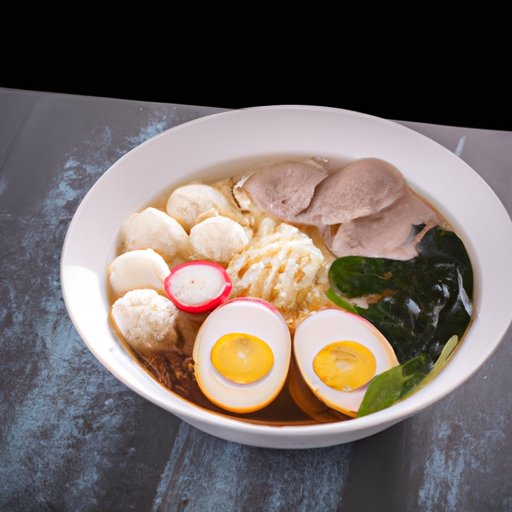
Introduction
Ramen has become a beloved staple in many households, with its delicious, savory broth and customizable toppings. However, the key to a perfect bowl of ramen lies in the broth. In this article, we will be exploring five different approaches to making and customizing ramen broth, providing step-by-step instructions, ingredient exploration, regional variations, and broth customization options. Whether you’re a ramen rookie or an experienced chef, this guide will help you create the perfect bowl of ramen with the broth tailored to your taste.
Step-by-Step Guide
Before we dive into the different approaches to making ramen broth, let’s start with the basic ingredients:
- Chicken carcasses, pork bones, or a combination of both
- Water
- Garlic
- Ginger
- Green onions
- Kombu (dried kelp)
- Bonito flakes (dried fish flakes)
Next, let’s move on to the step-by-step instructions for making ramen broth:
- Roast the chicken carcasses and pork bones in the oven at 400°F for 30-45 mins until browned.
- Place the roasted bones in a large stock pot, and cover with cold water.
- Bring the water to a boil, then turn the heat to low to simmer.
- After an hour of simmering, remove the scum and impurities that have risen to the top.
- Add garlic, ginger, green onions, and kombu to the pot then let simmer for another 3-4 hours.
- During the last 30 minutes, add bonito flakes and then remove from heat once done.
- Strain the broth into a clean pot using a fine mesh strainer.
- Refrigerate or freeze the broth until ready to use.
Ingredient Exploration
There are a variety of ingredients that can be used to make ramen broth, and each has a distinct impact on the flavor and texture of the broth. Here are some of the most common ingredients:
- Chicken carcasses and pork bones: These are the primary ingredients for most ramen broths and provide a deep, rich flavor.
- Kombu: This seaweed adds umami flavor and can help thicken the broth.
- Bonito flakes: Made from dried fish flakes, this ingredient gives the broth a distinct smoky flavor.
- Miso paste: This soybean paste can be added to animal-based broths for an earthy, savory flavor.
- Soy sauce: This adds saltiness and an umami taste to the broth.
- Sake: This rice wine can add depth to the flavor of the broth.
- Vegetables: Carrots, celery, and onions can be added to enhance the flavor of the broth and add additional health benefits.
There are also some potential substitutes if certain ingredients are not available. For example, dulse or nori can be used as a substitute for kombu, while vegetable broth can be used as a substitution for animal-based broths for a vegetarian or vegan option.
Regional Variations
There are many regional variations of ramen broth across Japan. Here are some unique variations:
- Tonkotsu: Originating in Fukuoka, this creamy and hearty broth is characterized by the use of pork bones and cooked for over 12 hours for maximum flavor.
- Shoyu: This is a classic soy sauce-based broth that is typically lighter in color and has a cleaner taste than other variations.
- Miso: A specialty of Hokkaido, this is a creamy and hearty broth made by adding miso paste to the broth after it has been cooked.
- Shio: This clear, salt-based broth is popular in Kyushu and is made using sea salt and chicken bones.
- Nagoya: This variation features a darker, richer broth made by boiling pork bones and chicken with tare sauce and soy sauce.
Each regional variation uses different ingredients, seasoning, and preparation methods, providing unique and distinct flavors that cater to different tastes.
Broth Customization
Customization is a key aspect of making a great bowl of ramen, and the broth is no exception. There are four key elements to ramen broth: soup, tare (seasoning), oil, and toppings. Here are some suggestions for how to mix and match them for a personalized bowl of ramen:
- Soup: Experiment with different broths, such as tonkotsu or miso, to find the one that best suits your preferences.
- Tare: Tare is the seasoning sauce added to the soup, and there are a variety of tare flavors available, from salty and savory to sweet and spicy.
- Oil: Adding a small amount of oil, such as chili oil or sesame oil, can enhance the flavor of the broth and create a silky texture.
- Toppings: There are endless topping options available, from traditional items like chashu and bamboo shoots to non-traditional options like corn or kimchi.
Leftovers Ideas
If you find yourself with leftover ramen broth, don’t let it go to waste! There are a variety of ways to repurpose it into other dishes:
- Noodle soups: The broth can be used as a base for noodle soups, such as udon or soba noodles.
- Stews: Use the broth as a base for hearty stews or casseroles, replacing the traditional chicken or beef broth.
- Gravies: The broth can be reduced to make a flavorful gravy for meats and vegetables.
Conclusion
There are many different approaches to making ramen broth, each of which can be customized to your preferences. Whether you prefer a creamy tonkotsu or a salty shoyu broth, experimenting with different ingredients and seasonings can help you create the perfect bowl of ramen. We hope this guide has inspired you to try making your own ramen broth and explore the vast array of flavors and textures that this beloved dish has to offer.




